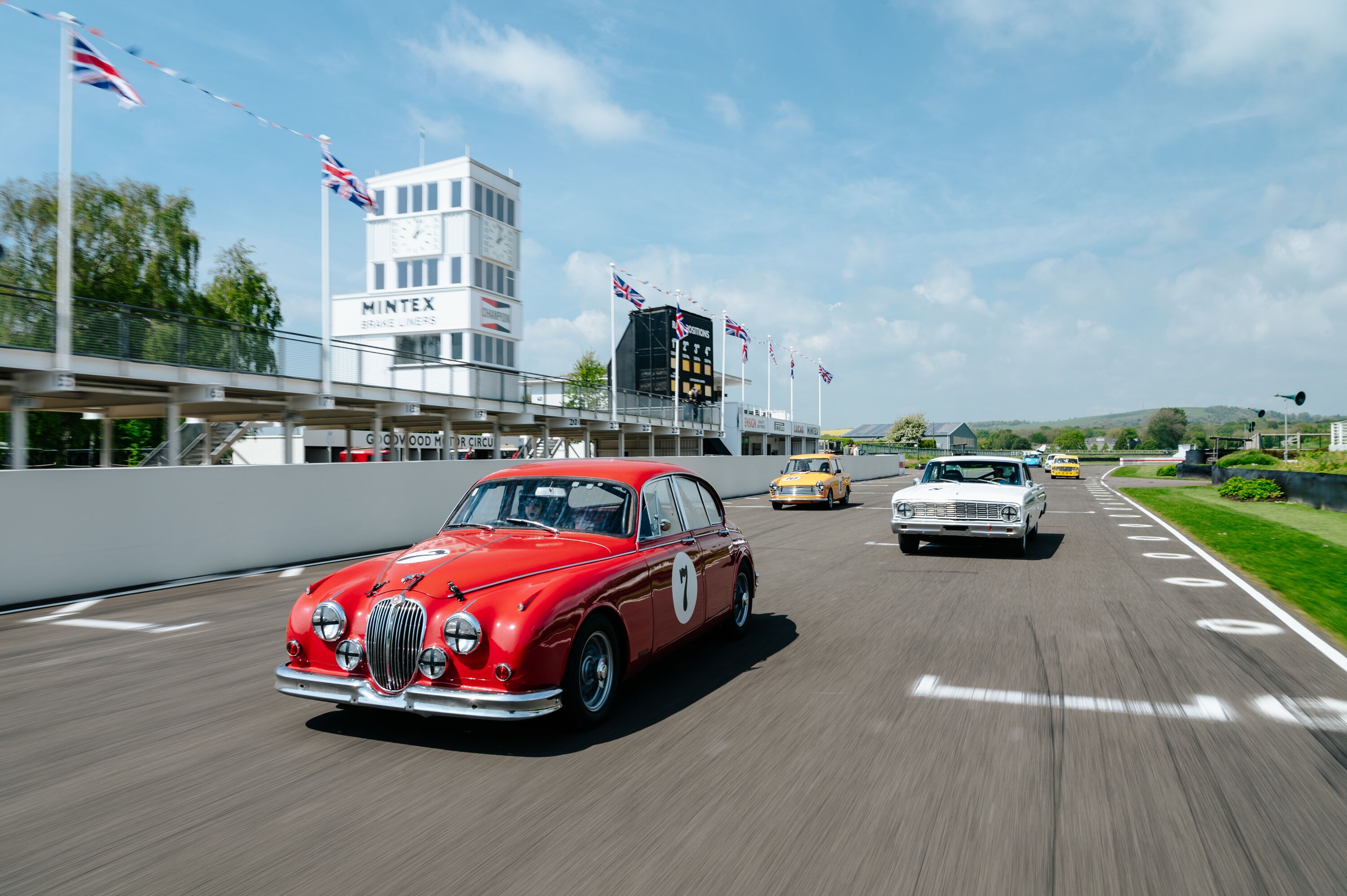The Tipo B: Alfa Romeo’s pre-war F1 influencer
As we mark 75 years of the Formula 1 World Championship in 2025, it’s important to acknowledge how pre-war Grand Prix cars and drivers set the template for the sport we know today. That’s a part of why the choice of Alfa Romeo as the celebrated marque at this year’s Goodwood Revival is so apt.
Lest we forget, the grand Italian car maker with the clover leaf badge was at the epicentre of motor racing in the 1920s and ’30s, much as Ferrari – its former customer and de facto works team – was to become post-war. Alfa and its beautiful cars were the heart and soul of motorsport.

And of all its thoroughbred machinery, there’s one that stands out as the most striking and successful, influencing everything that followed. Like all great racing cars, the Tipo B ‘Monoposto’ – later known as the P3 – moved the game on when it first took a bow in 1932, then defiantly kept the Italian end up as the shock and awe of the Nazi-funded Mercedes-Benz and Auto Union teams swept through the Grand Prix scene.
The Tipo B logged nearly 50 wins in races both major and minor, but there’s one specific and special victory that has gilded the P3 in racing immortality: Tazio Nuvolari’s day of days, when he defeated and humiliated the Silver Arrows in their own backyard at the 1935 German Grand Prix.
Born for a new era
Grand Prix racing was in a ragged state at the dawn of the 1930s, in the wake of the Wall Street Crash and the failure of the original Manufacturers’ World Championship (which Alfa had won in 1925, then promptly walked away from). Stung by manufacturer apathy, governing body L’Association Internationale des Automobile Clubs Reconnus (AIACR) fell back on an open Formula Libre in 1931, then for the following year ruled that racing cars no longer needed two seats.
Now, single-seaters were nothing new. The Marmoun Wasp, winner of the inaugural Indy 500 way back in 1911, was a monoposto. Yet even after riding mechanics were banned following the death of Sunbeam’s Tom Barrett at San Sebastian in 1924, twin-seaters shorn of cycle-wings and headlamps remained common. Here was an opportunity to build specialised designs – and Alfa grabbed it.

Vittorio Jano: master craftsman
The Tipo B was the creation of a colossus of automotive design. Vittorio Jano, an Italian of Hungarian descent, joined Alfa Romeo as chief designer from Fiat in 1923 and immediately came up with the P2 Grand Prix car, winner of that inaugural World Championship. Next, he fashioned the fabulous 6C sportscars that improved Alfa’s financial state and all but created the Grand Tourer as we know it today.
Jano was also the ingegnere behind the two-seat 8C 2300 of 1931 – later known as the Monza – and the Tipo A, a 980kg beast powered by two supercharged 117PS (86kW) six-cylinders sitting side by side. A long way short of perfection, lessons learned carried over into its successor.
In contrast, the Monoposto was less radical and more refined – and its packaging was close to perfection. Originally powered by a 2.6-litre straight-eight consisting of two alloy blocks of four separated by a gear tower, these drove twin overhead camshafts operating two valves per cylinder and boosted by back-to-back Roots-type superchargers. It weighed in at 700kg with a narrow chassis and cockpit of just 66cm and boasted a torquey 218PS (160kW) at 5,600rpm.
The Tipo B had sufficient power, notable agility, was reliable from the off – and an obvious beauty. New signing Rudolf Caracciola was enraptured and compared it to a ballerina.

Domination, trials and tribulation
Introduced mid-1932, Nuvolari won first time out as the Tipo B claimed half-a-dozen victories and mopped up all three major Grands Prix in Italy, France and Germany.
But, employing the world’s two best drivers in Nuvolari and Caracciola, with Alfa Corse answering directly to Mussolini, was a classically combustible case of two bulls in one field. It was never going to last. Then, once again feeling the financial pinch in such terribly straitened times, Alfa Corse pulled its old withdrawal act.
For 1933, Nuvolari found himself in a fall-back 2.6-litre 8C Monza run by the semi-works Scuderia Ferrari of Modena – and jumped ship to Maserati mid-season to drive its 8CM single-seater. Embarrassed to lose Italy’s greatest driver, in August Alfa finally released its fleet of Tipo Bs to Ferrari, to all intents and purposes now the works team, and that allowed Luigi Fagioli and Louis Chiron to pull out three wins apiece.
But the writing was on the wall: the Tipo B was beginning to wheeze in the face of its opposition. Meanwhile, for 1934, the AIACR acted to create some form of regulation, introducing for the first time a formula based on a minimum weight of 750kg for its 500km Grands Prix. The Tipo B was updated with more power from an extra 251cc, and became longer and wider to boot.

The season started well. Stunning newcomer Guy Moll won the Monaco Grand Prix, finished second to ruthless team-mate Achille Varzi in Tripoli and then defeated the new Auto Unions at Berlin’s Avusrennen, in a car featuring a special streamlined body created by Breda aerodynamicist Cesare Pallavicino and featuring the first 3.2-litre engine. But Moll’s promise was cruelly ripped away along with his life when, in August, he lost control of his P3 in the Coppa Acerbo at Pescara. He remains one of motor racing’s great lost what-might-have-beens.
In July at Montlhéry, Chiron had led home a glorious Tipo B 1-2-3 at the French Grand Prix. But thereafter the German cars stepped up, thanks to their leaps in capacity and horsepower, independent suspension and hydraulic brakes. The Alfas were increasingly left with the crumbs at minor races as the era of the mighty Silver Arrows kicked in.

Nuvolari’s greatest victory
In 1935, the Tipo B P3 was outclassed and breathless in the European Championship, although victories elsewhere continued to rack up – among them was Carlo Pintacuda’s on the Mille Miglia aboard a two-seat conversion with cycle wings and headlamps.
But the P3’s greatest moment was yet to come, in the hands of the genius Nuvolari – back at Alfa after arch rival Varzi beat him to a seat at Auto Union – and in tricky conditions at the fearsome Nürburgring, with help from Englebert’s tailored tyres and a mix of bad luck and poor judgement from Mercedes-Benz’s Manfred von Brauchitsch.
The Silver Arrows line-up pointed surely to Italian defeat. In the Mercedes corner, Carraciola, fresh from victories in the French and Belgian Grands Prix, plus the ’Ring’s Eifelrennen, supported by von Brauchitsch, Fagioli and two promising Germans: Hanns Geier and ex-mechanic Hermann Lang. At Auto Union, where its V16 stretched to 5.6 litres, was Hans Stuck, Varzi and a brilliant newcomer: Bernd Rosemeyer.
Nuvolari’s straight-eight was out to 3.2 litres, but he must have felt this was a lost cause; he was down 101PS (75kW) and 25mph on the German thoroughbreds. Still wiry at 42, and greying around the temples, he’d won at Pau, Bergamo, Biella and Turin – where the Germans had been conspicuous by their absence. Yes, he’d started the French Grand Prix from the front row and set the race’s fastest lap, but the overstretched P3 had wilted early.

Now here he was, drawn on the second row and up to second place by the end of the first lap. Caracciola set the early pace on a track dampened by overnight rain, as Nuvolari slipped behind Rosemeyer, Fagioli, team-mate Chiron and von Brauchitsch on lap two. But the picture soon changed.
Rosemeyer thumped a bank and pitted for new tyres as Nuvolari moved back up the order. Second by lap nine, he was the race leader on laps ten and 11 as a recovering Rosemeyer tracked him. Nuvolari had to push because he knew his pit stop would be slower than his rivals’ – but it was made worse when the winding handle on his refuelling equipment snapped.
As his tank was refilled via churns, an agitated and impatient Nuvolari raged with wheel hammer in hand, stationary for 2minutes 47seconds. Von Brauchitsch’s stop had lasted all of 47seconds. But the Mercedes was hard on its tyres and its driver was taking a chance, opting for just one stop instead of two.

Nuvolari was now inspired. He made up four places in a single lap, aided by a long stop for Fagioli, a cracked fuel pipe for Rosemeyer and Caracciola feeling unwell. Von Brauchitsch responded to the Italian threat with a lap record, but still Nuvolari closed and closed and closed.
The German pressed on, refusing a splash and dash to defend his 35second lead – then his luck ran out. A rear tyre burst at the Karussell on the last lap and Nuvolari swept past for his greatest victory, in front of 300,000 and a furious SS.
Drowned in a giant victory wreath, Nuvolari handed the embarrassed organisers a recording they lacked – his country’s national anthem. His salute was half-hearted and bent-armed as it crackled over the PA. The Tipo B was a spent force at the pinnacle of Grand Prix racing, but in the hands of Italy’s greatest maestro, not on this day.
Tickets for the Goodwood Revival are now available and you can save up to 10% when you buy before 1st May 2025 with early bird pricing.
1932 French Grand Prix image courtesy of Getty Images.
All other images courtesy of Motorsport Images.
race
historic
alfa romeo
tipo b
P3
tazio nuvolari
The Prologue
celebrated marque







